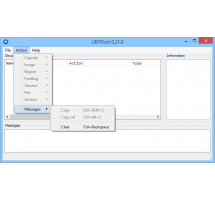
- #Uefitool add uefi shell to bios how to
- #Uefitool add uefi shell to bios driver
- #Uefitool add uefi shell to bios code
- #Uefitool add uefi shell to bios free
BIOS files with a “standard” suffix (like *.rom, *.bin.Then navigate to the folder, where the related BIOS file is located. To open a certain BIOS file, hit onto “File” from the UEFITool Toolbar and choose the option “Open image file…”.This will make the tree view look much better and next time it will look the same way because column widths and window position are stored in system-specific settings storage. To combat it effectively, you can select the root element, press numpad * to open the whole tree at once and double-click onto the borders between column headers to resize them to content. When you are opening the UEFITool for the first time, it has default window layout, which doesn’t show the Text column, makes GUIDs too short etc.It is generally a good idea to maximize the UEFITool GUI window from scratch to see later on the complete content of the opened BIOS file.After having done a double-click onto the UEFITool.exe file, you will see its GUI.The BIOS file name and its suffix (except *.exe) doesn’t matter.īefore you start the UEFITool, you should make sure, that the related BIOS file complies with these requirements. Only previously unzipped “pure” AMI UEFI BIOSes can be opened and modified by the UEFITool.Since these files with the EFI extension do neither contain a GUID header nor infos about dependencies, size etc., they are a little bit smaller sized than the uncompressed. If you want to extract or replace just this functionally essential part of the EFI Module, you need resp.
#Uefitool add uefi shell to bios driver
The code, which is responsable for the function of the DXE Driver is located within the Core of the EFI module named “PE32 Image body”.GUID header and infos about dependencies, size, version etc.) in compressed or uncompressed form.
#Uefitool add uefi shell to bios code
This file with the FFS extension contains the complete code of the related EFI module (incl.

Note: the UEFITool can accomplish similar tasks with LEGACY mode Option ROM modules as well, but this is more complicated and not the topic of this guide.Įxtract/insert/replace an EFI BIOS module
#Uefitool add uefi shell to bios how to
Since the UEFITool “maker” CodeRush himself hasn’t yet published detailed instructions regarding the usage of all specific UEFITool options, I decided to offer here a short guide just about how to insert/replace the most important EFI modules into an AMI UEFI BIOS. That is why I recommend to use the UEFITool, if you wantĪ) to insert a previously not present EFI module into a specific mainboard UEFI BIOS orī) to manually replace an already existing EFI module by another version or variant.

#Uefitool add uefi shell to bios free
is free and can be used by everyone (since it is an “Open Source” project, there are no restrictions). it automaticly corrects the checksum of an FFS file while inserting/updating it) andģ. works absolutely precise and very safe (e.g. can modify all “pure” (=extracted) AMI UEFI BIOS files (no matter whether its structure is Aptio IV or Aptio V),Ģ. Both tools have been developed and is still kept up-to-date by our Forum member CodeRush.Īt first view the usage of the UEFITool may not be as comfortable and easy to understand as the usage of the related AMI Aptio IV or Aptio V UEFI MMTool, but these are the benefits the users of the UEFITool will get:ġ. My favorite UEFI BIOS modding tool for these specific tasks is the normal “UEFITool” (don’t use the _NE variant for this purpose). (AMI) doesn’t allow to offer their AMI Aptio UEFI MMTools for the public, you may have to use another tool, if you want to manually modify an AMI UEFI BIOS according to your wishes. Since the company American Megatrends Inc. All users, who want to manually optimize the UEFI BIOS of their manboard/system:


 0 kommentar(er)
0 kommentar(er)
